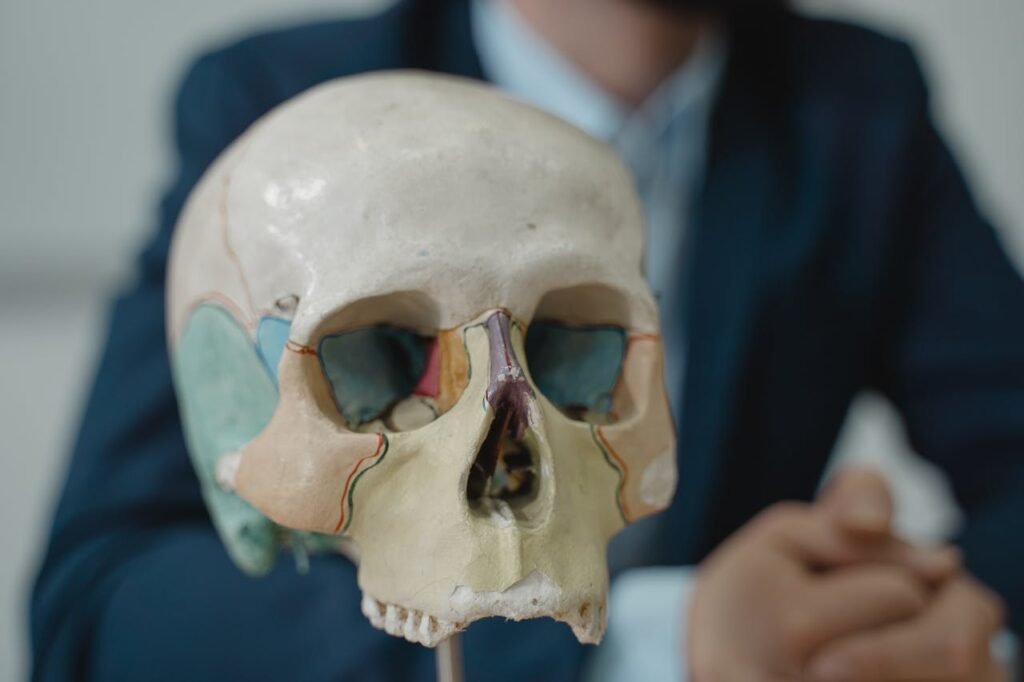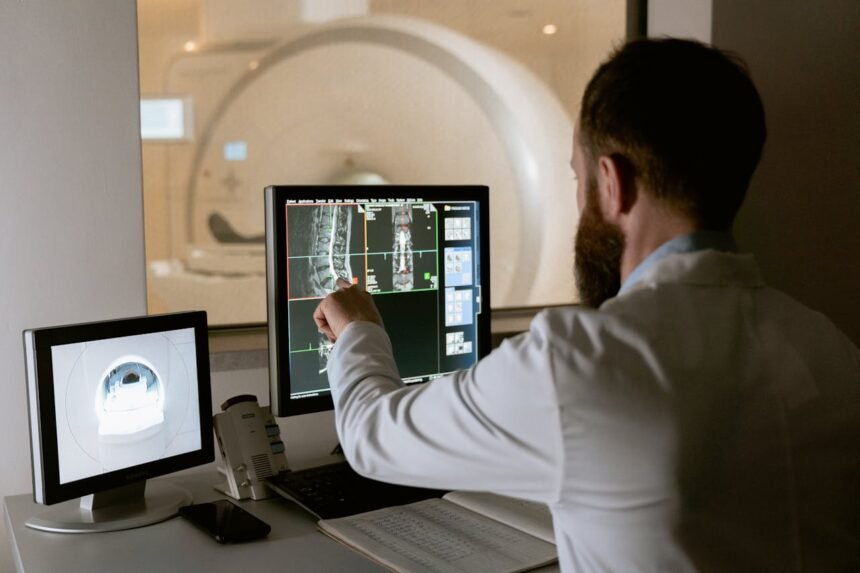Osteoporosis affects over 3 million people in the United Kingdom, with approximately 500,000 fragility fractures occurring annually, according to the Royal Osteoporosis Society. This “silent disease” weakens bones gradually without symptoms until a fracture occurs, earning its reputation as a major public health concern. The NHS estimates that osteoporosis costs the UK economy over £4.4 billion annually through fracture treatment and care, highlighting the importance of prevention, early detection, and appropriate management.
Understanding Osteoporosis
Osteoporosis, literally meaning “porous bones,” is a condition characterised by decreased bone density and deteriorated bone tissue microarchitecture, leading to increased fracture risk. The World Health Organization defines osteoporosis based on bone mineral density measurements compared to healthy young adults.
Bone Biology and Remodelling:
Normal Bone Structure:
Bone is living tissue constantly undergoing renewal:
- Cortical bone: Dense outer shell providing strength
- Trabecular bone: Spongy inner network absorbing shock
- Bone matrix: Collagen framework providing flexibility
- Minerals: Calcium and phosphate providing hardness
Bone Remodelling Process:
- Bone resorption: Osteoclasts break down old bone
- Bone formation: Osteoblasts build new bone tissue
- Balance: Healthy bones maintain equilibrium between processes
- Peak bone mass: Achieved around age 30
- Age-related decline: Begins around age 35-40
Osteoporosis Classification:
Primary Osteoporosis:
- Type I (Postmenopausal): Oestrogen deficiency-related
- Type II (Age-related): Affects both men and women over 70
- Idiopathic: Occurs in younger adults without clear cause
Secondary Osteoporosis:
Caused by underlying conditions or medications:
- Endocrine disorders (hyperthyroidism, hyperparathyroidism)
- Gastrointestinal conditions affecting absorption
- Chronic inflammatory diseases
- Medication-induced (corticosteroids, anticonvulsants)
Diagnostic Criteria:
T-Score Classification:
Based on dual-energy X-ray absorptiometry (DXA) scans:
- Normal: T-score -1.0 or higher
- Osteopenia: T-score between -1.0 and -2.5
- Osteoporosis: T-score -2.5 or lower
- Severe osteoporosis: T-score -2.5 or lower with fragility fracture
Risk Factors for Osteoporosis
Understanding osteoporosis risk factors enables targeted prevention and early intervention. The International Osteoporosis Foundation identifies multiple contributing factors.
Non-Modifiable Risk Factors:
Age:
- Risk increases significantly after age 50
- Bone loss accelerates with advancing age
- Both men and women affected, though timing differs
- Lifetime fracture risk increases exponentially
Gender:
- Women have 4 times higher risk than men
- Postmenopausal oestrogen decline accelerates bone loss
- Men typically develop osteoporosis 10-15 years later
- Smaller peak bone mass in women contributes to risk
Genetics:
- Family history of osteoporosis or fractures increases risk
- Genetic factors account for 60-80% of peak bone mass
- Specific gene variants affect bone metabolism
- Ethnicity influences bone density patterns
Body Frame:
- Small, thin body frame increases risk
- Lower peak bone mass in smaller individuals
- Less mechanical stress on bones
- Reduced muscle mass affecting bone stimulation
Modifiable Risk Factors:
Hormonal Factors:
- Early menopause: Before age 45 increases risk significantly
- Hypogonadism: Low testosterone in men
- Amenorrhoea: Absent menstrual periods in younger women
- Hormone therapy: Affects bone metabolism
Lifestyle Factors:
Physical Inactivity:
- Sedentary lifestyle increases bone loss
- Weight-bearing exercise essential for bone health
- Prolonged bed rest accelerates bone loss
- Lack of mechanical stress weakens bones
Smoking:
- Directly toxic to bone-forming cells
- Reduces calcium absorption
- Lowers oestrogen levels in women
- Increases fracture risk by 25-85%
Excessive Alcohol:
- More than 2-3 units daily increases risk
- Interferes with bone formation
- Affects calcium and vitamin D metabolism
- Increases fall risk
Poor Nutrition:
- Calcium deficiency: Primary building block for bones
- Vitamin D insufficiency: Essential for calcium absorption
- Protein inadequacy: Needed for bone matrix formation
- Excessive caffeine: May interfere with calcium absorption
Medical Conditions:
Endocrine Disorders:
- Hyperthyroidism accelerates bone turnover
- Hyperparathyroidism causes calcium loss
- Cushing’s syndrome increases bone breakdown
- Type 1 diabetes affects bone formation
Gastrointestinal Conditions:
- Coeliac disease impairs nutrient absorption
- Inflammatory bowel disease affects vitamin D metabolism
- Gastric bypass surgery reduces absorption
- Chronic liver disease affects vitamin D conversion
Rheumatic Diseases:
- Rheumatoid arthritis increases bone loss
- Systemic lupus erythematosus
- Ankylosing spondylitis
- Often complicated by corticosteroid treatment
Medications Affecting Bone Health:
Corticosteroids:
- Greatest medication-related risk factor
- Dose and duration dependent
- Affects both bone formation and resorption
- Risk increases with doses >5mg prednisolone daily
Other High-Risk Medications:
- Anticonvulsants (phenytoin, carbamazepine)
- Proton pump inhibitors (long-term use)
- Aromatase inhibitors for breast cancer
- GnRH agonists for prostate cancer
- Anticoagulants (heparin, warfarin)

Symptoms and Complications
Osteoporosis is often asymptomatic until complications occur, earning its designation as a “silent disease.” The National Osteoporosis Society emphasises the importance of understanding when symptoms may indicate problems.
Early Warning Signs:
Often No Symptoms:
- Bone density loss occurs gradually
- No pain or obvious signs initially
- May have subtle height loss
- Detected through screening or after fracture
Possible Early Indicators:
- Gradual loss of height (>1.5 inches)
- Development of stooped posture
- Back pain from vertebral changes
- Brittle or weak fingernails (controversial)
Fracture Complications:
Vertebral Fractures:
Most common osteoporotic fractures:
- Often occur without obvious trauma
- May cause sudden severe back pain
- Can be asymptomatic (“silent fractures”)
- Lead to height loss and kyphosis (hunched back)
- Increase risk of subsequent fractures
Hip Fractures:
Most serious osteoporotic fractures:
- Usually require hospitalisation and surgery
- Significant mortality risk (20% within 1 year)
- Major cause of disability and loss of independence
- Often precipitated by falls
Wrist Fractures:
- Often first sign of osteoporosis
- Usually occur from fall on outstretched hand
- May indicate need for further bone assessment
- Can cause long-term pain and dysfunction
Other Fracture Sites:
- Ribs (may occur from coughing or minor trauma)
- Pelvis (can cause severe pain and mobility issues)
- Upper arm (humerus) fractures
- Any fracture from minimal trauma warrants investigation
Impact on Quality of Life:
Physical Effects:
- Chronic pain from fractures
- Reduced mobility and independence
- Fear of falling leading to activity restriction
- Respiratory problems from spinal deformity
Psychological Impact:
- Depression and anxiety
- Loss of confidence and self-esteem
- Social isolation
- Fear of future fractures
Diagnosis and Assessment
Early detection of osteoporosis enables intervention before fractures occur. The NICE guidelines provide clear recommendations for assessment and diagnosis.
Bone Mineral Density Testing:
DXA Scanning:
Gold standard for osteoporosis diagnosis:
- Procedure: Low-dose X-ray measuring bone density
- Sites: Usually spine and hip, sometimes forearm
- Results: T-scores and Z-scores provided
- Precision: Highly accurate and reproducible
- Radiation: Minimal exposure (less than chest X-ray)
Who Should Have DXA Scanning:
- Women aged 65 and older
- Men aged 70 and older
- Younger adults with risk factors
- Anyone with fragility fracture
- Before starting high-risk medications
Alternative Imaging:
- Quantitative ultrasound: Heel scans for screening
- CT scanning: Can detect vertebral fractures
- MRI: Detailed assessment of bone quality
- Plain X-rays: Show fractures but not early bone loss
Fracture Risk Assessment:
FRAX Calculator:
WHO-developed tool estimating 10-year fracture risk:
- Combines clinical risk factors with bone density
- Calculates major fracture and hip fracture risk
- Guides treatment decisions
- Available online and in clinical practice
Q-Fracture Tool:
UK-developed alternative to FRAX:
- Incorporates additional risk factors
- Validated in UK population
- Used in some GP practices
- Includes more comorbidities
Laboratory Tests:
Routine Blood Tests:
- Full blood count
- Calcium, phosphate, and alkaline phosphatase
- Kidney and liver function
- Thyroid function tests
- 25-hydroxyvitamin D level
Specialised Tests When Indicated:
- Parathyroid hormone
- 24-hour urine calcium
- Bone turnover markers
- Testosterone (men)
- Protein electrophoresis
Prevention Strategies
Osteoporosis prevention should begin early in life to maximise peak bone mass and minimise age-related bone loss. The Royal Osteoporosis Society advocates for lifelong bone health strategies.
Optimising Peak Bone Mass:
Childhood and Adolescence:
- Adequate calcium intake (700-1200mg daily)
- Sufficient vitamin D (10 micrograms daily minimum)
- Regular weight-bearing physical activity
- Avoiding smoking and excessive alcohol
- Healthy body weight maintenance
Young Adults:
- Continue bone-healthy lifestyle
- Address any eating disorders
- Maintain regular menstrual cycles
- Avoid excessive dieting
- Build strong bones before age 30
Lifestyle Interventions:
Calcium Intake:
Recommended daily amounts:
- Adults 19-64: 700mg daily
- Over 65: 800-1200mg daily
- Postmenopausal women: 1200mg daily
- Food sources preferred: Dairy, leafy greens, sardines, almonds
- Supplements if needed: Calcium carbonate or citrate
Vitamin D:
Essential for calcium absorption:
- UK recommendation: 10 micrograms (400 IU) daily
- Higher doses may be needed: Especially in deficiency
- Sources: Sunlight, oily fish, fortified foods, supplements
- Testing recommended: For high-risk individuals
Physical Activity:
Weight-bearing and muscle-strengthening exercises:
- Weight-bearing: Walking, jogging, dancing, tennis
- Resistance training: Weights, resistance bands
- Balance exercises: Reduce fall risk
- Frequency: At least 150 minutes moderate activity weekly
- Progression: Gradually increase intensity and duration
Fall Prevention:
Home Safety:
- Remove trip hazards (loose rugs, clutter)
- Improve lighting, especially stairs
- Install handrails and grab bars
- Non-slip mats in bathroom
- Appropriate footwear
Medical Factors:
- Review medications affecting balance
- Treat vision and hearing problems
- Manage blood pressure (avoid postural hypotension)
- Address muscle weakness
- Consider physiotherapy assessment
Treatment Options
Osteoporosis treatment aims to reduce fracture risk through medications, lifestyle modifications, and fall prevention. The European Society for Clinical and Economic Aspects of Osteoporosis provides treatment guidelines.
Pharmacological Treatments:
Bisphosphonates:
First-line treatment for most patients:
- Alendronic acid: Weekly oral tablet
- Risedronate: Daily or weekly options
- Ibandronate: Monthly oral or quarterly IV
- Zoledronic acid: Annual intravenous infusion
Mechanism: Inhibit bone breakdown by osteoclasts
Effectiveness: Reduce fracture risk by 30-70%
Side effects: Gastrointestinal irritation, rare jaw osteonecrosis
Duration: Usually 3-5 years initially
Alternative Treatments:
Denosumab:
- Monoclonal antibody given by 6-monthly injection
- Inhibits osteoclast formation and activity
- Very effective for fracture prevention
- Suitable for patients intolerant of bisphosphonates
- Requires indefinite treatment
Hormone Replacement Therapy (HRT):
- Effective for postmenopausal osteoporosis prevention
- Consider risks and benefits carefully
- Usually reserved for younger postmenopausal women
- May be combined with osteoporosis-specific treatments
Selective Oestrogen Receptor Modulators:
- Raloxifene: Reduces vertebral fracture risk
- Oestrogen-like effects on bone
- May reduce breast cancer risk
- Increases venous thromboembolism risk
Anabolic Agents:
For severe osteoporosis:
- Teriparatide: Daily injection for maximum 2 years
- Abaloparatide: Similar mechanism to teriparatide
- Stimulate new bone formation
- Very expensive, specialist use only
Calcium and Vitamin D Supplementation:
When Recommended:
- Inadequate dietary intake
- Malabsorption syndromes
- Limited sun exposure
- Taking osteoporosis medications
Dosing:
- Calcium: 500-600mg daily (in addition to dietary intake)
- Vitamin D: 800-1000 IU daily (higher if deficient)
- Combined preparations: Available for convenience
- Timing: Calcium best absorbed in divided doses
Monitoring Treatment:
DXA Scanning:
- Repeat after 2-3 years of treatment
- Assess response and guide continuation
- Significant improvement not always expected
- Stability may indicate treatment success
Biochemical Markers:
- Bone turnover markers may predict response
- Not routinely used in clinical practice
- Research tool for treatment monitoring
Living with Osteoporosis
Receiving an osteoporosis diagnosis can be frightening, but with appropriate treatment and lifestyle modifications, most people maintain active, independent lives.
Self-Management Strategies:
Medication Adherence:
- Take medications exactly as prescribed
- Understand proper administration (especially bisphosphonates)
- Don’t stop treatment without medical consultation
- Report side effects promptly
Exercise Programs:
- Work with physiotherapist to design safe program
- Focus on weight-bearing and resistance exercises
- Include balance training to prevent falls
- Avoid high-impact activities if fracture risk high
Dietary Planning:
- Ensure adequate calcium and vitamin D intake
- Maintain healthy body weight
- Limit alcohol consumption
- Consider dietitian consultation
Psychological Support:
Coping with Diagnosis:
- Education about condition reduces anxiety
- Connect with support groups
- Maintain social activities and relationships
- Focus on prevention rather than fear
Depression and Anxiety:
- Common after osteoporosis diagnosis
- Professional counselling may help
- Antidepressants safe with osteoporosis medications
- Regular exercise improves mood
Support Resources:
Patient Organisations:
- Royal Osteoporosis Society: 0808 800 0035
- National Osteoporosis Society: Information and support
- Local support groups: Peer support and practical advice
- Online communities: Forums and educational resources
Healthcare Team:
- GP: Ongoing care and monitoring
- Bone specialist: Endocrinologist or rheumatologist
- Physiotherapist: Exercise prescription and fall prevention
- Dietitian: Nutritional assessment and advice
Special Populations
Certain groups require specific considerations for osteoporosis prevention and treatment:
Men with Osteoporosis:
Underdiagnosis:
- Often overlooked in clinical practice
- Later onset than women
- Different risk factor profile
- Same diagnostic criteria and treatments
Causes:
- Testosterone deficiency
- Alcohol abuse
- Corticosteroid use
- Secondary causes more common
Premenopausal Women:
Causes:
- Eating disorders and amenorrhoea
- Chronic diseases
- Medication-induced
- Idiopathic osteoporosis
Treatment Considerations:
- Bisphosphonates generally avoided
- Focus on lifestyle interventions
- Address underlying causes
- Specialist referral recommended
Older Adults:
Multiple Comorbidities:
- Increased fracture risk
- Multiple medications
- Fall risk management crucial
- Quality of life considerations
Treatment Goals:
- Balance benefits and risks
- Consider life expectancy
- Maintain independence
- Prevent hip fractures
Future Developments
Osteoporosis research continues advancing with new treatments and diagnostic approaches:
Emerging Treatments:
- Romosozumab: Anabolic agent building bone while reducing resorption
- Cathepsin K inhibitors: New approach to reducing bone breakdown
- Combination therapies: Multiple mechanisms for severe cases
- Personalised medicine: Genetic testing to guide treatment selection
Research Areas:
- Biomarkers for fracture risk prediction
- Novel drug targets
- Improved methods for assessing bone quality
- Prevention strategies for high-risk populations
Conclusion
Osteoporosis represents a significant but largely preventable public health challenge. Through understanding risk factors, implementing lifelong bone health strategies, and accessing appropriate screening and treatment when needed, fractures and their consequences can often be prevented.
The key to successful osteoporosis management lies in early intervention, combining evidence-based medical treatments with lifestyle modifications including adequate nutrition, regular exercise, and fall prevention strategies. Resources from organisations like the Royal Osteoporosis Society and the NHS provide valuable information and support.
Remember that osteoporosis is not an inevitable consequence of ageing, and with appropriate prevention and treatment, most people can maintain strong bones and avoid fractures throughout their lives. Building bone health early and maintaining it throughout life is one of the best investments in long-term independence and quality of life.






